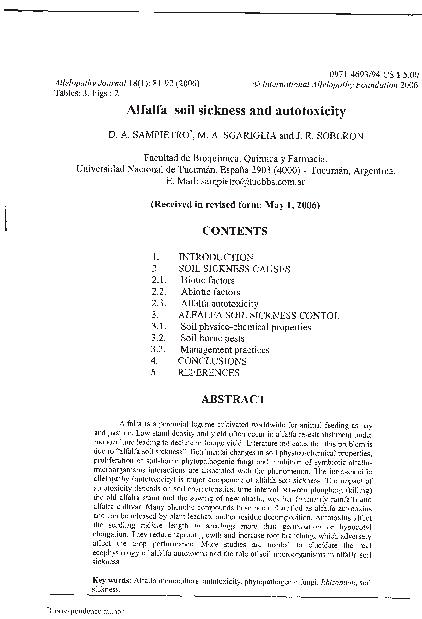Artículo
Alfalfa soil sickness and autotoxicity
Fecha de publicación:
06/2006
Editorial:
Allelopathy Journal
Revista:
Allelopathy Journal
ISSN:
0971-4693
Idioma:
Inglés
Tipo de recurso:
Artículo publicado
Clasificación temática:
Resumen
Alfalfa is a perennial legume cultivated worldwide for animal feeding as hay and pasture. Low stand density and yield often occur in alfalfa re-establishment under monoculture leading to decline in forage yield. Literature indicates that this problem is due to "alfalfa soil sickness". Detrimental changes in soil physico-chemical properties, proliferation of soil-borne phytopathogenic fungi and inhibition of symbiotic alfalfa-microorganisms interactions are associated with the phenomenon. The intra-specific allelopathy (autotoxicity) is major component of alfalfa soil sickness. The impact of autotoxicity depends on soil characteristics, time interval between ploughing (killing) the old alfalfa stand and the sowing of new alfalfa, weather (primarily rainfall) and alfalfa cultivar. Many phenolic compounds have been identified as alfalfa autotoxins and can be released by plant leachate and/or residue decomposition. Autotoxins affect the seedling radicle length in seedlings more than germination or hypocotyl elongation. They reduce taproot growth and increase root branching, which adversely affect the crop performance. More studies are needed to elucidate the real ecophysiology of alfalfa autotoxins and the role of soil microorganisms in alfalfa soil sickness.
Palabras clave:
ALFALFA MONOCULTURE
,
AUTOTOXICITY
,
PHYTOPATHOGENIC FUNGI
,
RHYZOBIUM
Archivos asociados
Licencia
Identificadores
Colecciones
Articulos(CCT - NOA SUR)
Articulos de CTRO.CIENTIFICO TECNOL.CONICET - NOA SUR
Articulos de CTRO.CIENTIFICO TECNOL.CONICET - NOA SUR
Citación
Sampietro, Diego Alejandro; Sgariglia, Melina Araceli; Soberon, Jose Rodolfo; Alfalfa soil sickness and autotoxicity; Allelopathy Journal; Allelopathy Journal; 18; 1; 6-2006; 81-92
Compartir




